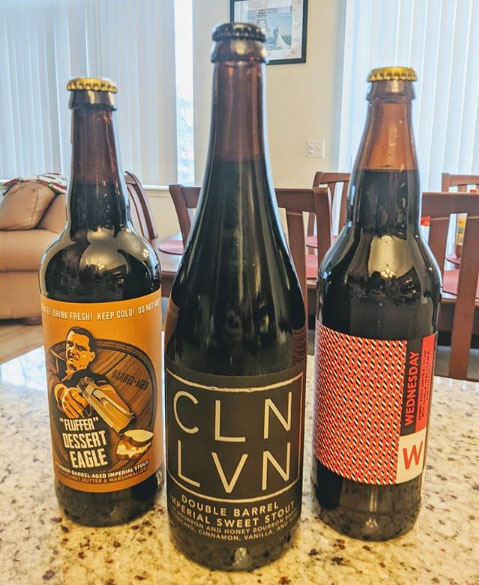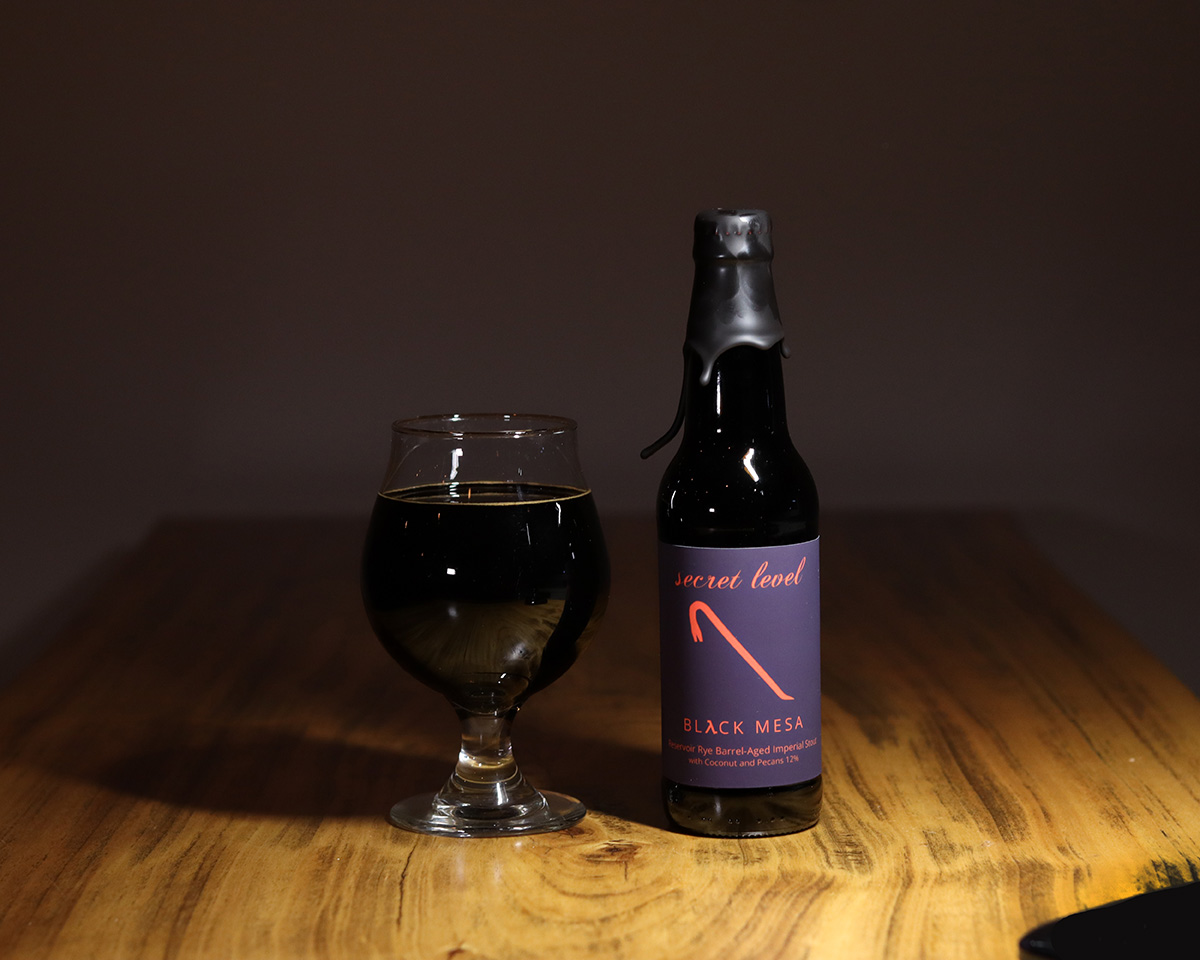
After a few years of experimenting, I've settled on a base recipe that's just too good for me to stop brewing. It's smooth, balanced, caramel-rich, not too roasty, and not too sweet. It's good with coffee, peanut butter, hazelnuts, and various other adjuncts. I've listed out some tips for working with various adjuncts below, but be sure to check out my guides on brewing a chocolate stout and brewing with maple syrup.
One of the pillars of the style is having a beer that comes with a full mouthfeel and generally feels "thick" on the tongue. There is no one trick that will make a thick stout, but several factors that work together to achieve this:
I was lucky enough to get advice from several successful brewers, with their pastry stouts being well-renowned nationwide. One of the best pieces of advice I received was a "rule of thumb" that has really opened my eyes on the style and helped me create my own recipes that are successful every time. Here it is.
There are usually three types of malt that make up the Stout Grist:
1. Base Malts
2. Crystal/Caramel Malts
3. Roasted Malts
The idea it to build up the base of the grist using Base, Crystal, and Chocolate malts first before adding any other roasted malts to your recipe. For a lower abv pastry stout, these malts should add to no more than 30 - 35 SRM. This will create a nice roast balance, but not too much. As you go higher in ABV, the higher your roasted malts should be, all the way to 130+ SRM.
This creates a nice roasty balanced stout base that isn't too roasty or astringent. Next, add Carafa III or Midnight Wheat malt (or any other, non-bitter or dehusked dark malt) to reach 36 - 40 SRM. Any more is overkill.
For less than 8% ABV: I would look to find this balance in 30-35 SRM for the base recipe, before adding Carafa III or Midnight Wheat.
For 8-10% ABV: Feel free to start using small percentages of roasted barley or black malt (up to 5%), until you are comfortable with the roast levels. Keep in mind that higher levels of residual sugars are higher in these beers, so they help offset the bitterness of roasted malts. You may also want to avoid using too much lactose in these beers to avoid cloying sweetness as they are naturally sweet.
For more than 11% ABV:If your final gravity is venturing into 1.050's+, breweries like Phase Three, 3 Sons and others often use 10% Chocolate malt along with 3-5% roased barley or other roasted malts. This is especially true in barrel-aged beers. Carafa Special II is a debittered malt, but adds wonderful chocolate flavor. Roast is your friend here, but experiment with proven recipes and figure out what you like.

Thick and chocolatey, this is the base stout that I go back to for creating different recipes, usually ones containing coffee and other adjuncts. These come out great in the 7-10% ABV range.
Grist
55.0% 2-row
15.0% Flaked Oats
10.0% Crisp Pale Chocolate
5.0% Simpsons DRC
5.0% Crisp Brown Malt
5.0% Honey Malt
4.0% Crisp Chocolate
1.0% Black Malt
(Optional - add more Black Malt or Chocolate Malt for a more roasty profile)
Numbers
OG: 1.100
FG: 1.028
US-05
Mash Temp: 155F
Hops: EKG (20 IBU)
Lactose (optional): 0.5lb for 5 gallon batch
Water Chemistry: Ca 151; Mg 22; Na 43; Cl 200; SO4 90; pH 5.4
Notes
Ferment for 2 weeks at 68F or below to avoid significant ester production. Let condition in keg for 2 weeks.
60 minute boil is standard for me, although longer boil times will add more caramel notes.

This is the absolute pinnacle of my brewing career so far. Thick, chocolatey, gooey, but somehow balanced by barrel and adjuncts. An amped-up version of Hypothesis.
Grist
50.5% 2-row
11.5% Flaked Oats
8.0% Crisp Chocolate
8.0% Crisp Pale Chocolate
5.7% Simpsons DRC
5.7% Crisp Brown Malt
5.7% Honey Malt
4.7% Carafa II Malt
Numbers
OG: 1.145
FG: 1.058
US-05
Mash Temp: 152F
Hops: Loral (60 IBU)
Water Chemistry: Ca 151; Mg 22; Na 43; Cl 180; SO4 90; pH 5.33
Notes
This was aged for 5 months in a 5 gallon Reservoir Rye bourbon barrel, then split into two:
Pecan and coconut variant
Vanilla variant
You can watch the full brewday discussion, aging, and tasting here:
Buy me a beer by supporting me on Patreon. You can also find me on Instagram.
One of pieces of advice I received about brewing with coffee is to anticipate the roast levels. If you are planning to add coffee at one point in the process, brew a recipe that has slightly less bitter roasted malts, as coffee adds a roastiness and bitterness of its own.
As for general tips for adding coffee, Scott Janish created an interesing guide to coffee beers. I tried something similar to a great degree, although adding coffee beans or grounds in a muslin bag to a chilled keg works wonders for me in terms of both flavor and aroma. Cold, kegged beer essentially creates a cold brew type environment, allowing all the good flavors to be extracted without the peppery notes or astringency. Adding beans to a room temperature fermenter is not recommended.
Many recipes call for a whole pound of lactose for a 5 gallon batch. I would be careful here, especially if brewing recipes with over 1.100 OG that don't have too much bitterness to offset the sweetness. Beers with this high of OG usually have a higher FG that helps add sweetness.
Personally, I like adding lactose little by little after I have kegged the beer and think that it needs more sweetness. Even then, I often use maltodextrin blended with lactose to add more body and thickness, as opposed to just sweet flavors.
One of my favorite adjuncts to add to a stout is hazelnuts. I haven't been impressed with any of the extracts I used so I always roast the nuts and add them directly to keg. The trick is to roast the nuts until they are well-browned, and toss them in a bowl with paper towels to help rid the nuts of the oils. Let them cool, add to a muslin bag, and steep them in the keg for a week or until you are happy with the flavors. Taste often!
A handy guide to roasting and adding hazelnuts.
Coconut is one of the most popular adjuncts because it's so damn good. Be wary of the high oil content here and be sure to get the unsweetened coconut. I toast my coconut at 300F until it's lightly browned, and toss it in paper towels between roast cycles to get rid of the oils. This shouldn't take more than 10-20 min. Then throw in muslin bag and add to keg for 1-2 weeks.
I've actually enjoyed a 50/50 mix of toasted and untoasted coconut as well. This has a slightly higher risk for infection, but I haven't had any issues just adding it to keg.
The filling has too much fat to be added, so my trick has always been to use the Oreo cookie pieces without the cream. Some folks separate the cookies from the filling, or just throw them in whole.
I've used 2 pounds for a 5 gallon batch and the flavor hasn't really come through. I would likely use 3-4 pounds next time as some friends had decent success using those amounts.
Contrary to popular belief, Chocolate malt is mostly a roasted malt with roasted espresso and very mild dark chocolate flavors. To brew a successful Chocolate stout, you'll need to use Pale Chocolate Malt alongside Brown malt to get flavors more resembling of a candy bar. I always finish these beers off with toasted cacao nibs to ensure a full spectrum of chocolate flavors. You can view the full Chocolate Stout Recipe here.
The trick to brew a maple syrup beer is to prevent maplefrom being fermented out by the yeast is to make sure that the yeast has completely dropped out and then treating your beer with Potassium Metabisulfite (Campden tablet) and Potassium Sorbate to prevent any further fermentation. Warning: some fermentation may still happen as these compounds do not kill the yeast, but rather stop it from growing/multiplying. Some fermentation may still take place, so leave the beer at fermentation temperatures for a week after adding maple.
I've seen folks recommend boiling the syrup down to make it thicker, richer, and more flavorful before adding it. I have yet to try this out but I'll be sure to report in when I do!
Since Maple Syrup does add a good amount of sugar to your beer, I would skip adding lactose and consider mashing at lower temperatures to prevent the beer from being too sweet. If it does end up too sweet, you can always add some coffee to help add a little roast and bitterness. Get the whole recipe and detailed instructions from the link at the beginning of this section.
I've had success brewing with real peanut butter, but it was a ton of work to de-oil it. PB2 is a nice substitute, but the flavor doesn't come through as well. What you want to do is supplement PB2 with some Brewer's Best Peanut Butter flavoring. It's fantastic on its own, and along with PB2, it creates a nicely saturated authentic peanut butter flavor.
The real peanut butter process I've had success with is described by Pratt Brewing on HomebrewTalk. Get organic peanut butter with a layer of oil on top, pour the oil out, then follow these steps:
Take some kind of large dish, like a pyrex dish, and line it with paper towels. Spread the peanut butter out evenly over the paper towels. Let it sit for a couple of days and then flip it onto some new paper towels. Repeat every 2-3 days over the course of like 10 to 15 days. (Keep the dish covered during this time of course).
I've enjoyed adding various nuts to my stouts. It's a perfect adjunct that doesn't make the beer too sweet, but it adds a pleasant, unique flavor to it. My favorite ones to brew with so far have been hazelnuts, but pecans came in close second.
What's worked best is to break up the nuts in half (with a mallet or rolling pin), then toast them in the oven at 350F for 10-20 min, until very aromatic. Soak dose nuts in your favorite beer for a week and enjoy fresh.
One of my favorite brews was a second runnings stout I made after a big beer that I called Tons of Pecans stout. I toasted 2.5lbs Trader Joe's pecans into 5 gallons of 1.062 stout and it came out wonderful. It had a real nice pecan pie vibe to it that was quite unique and it was awesome to drink it around Thanksgiving. I highly recommend brewing with these. I believe Costco has 3 lbs bags for sale for cheap.
I made a little extra base beer when I was making my Bourbon County Stout clone and treated it with coconut and almonds to make an Almond Joy/Mounds Bar themed beer. While the overall beer was a fantastic representation of the Mounds bar, the almonds were definitely in the background. I added 2 pounds for 3 gallons, but the almonds were just overpowered by the other adjuncts and weren't as strong of a flavor as other nuts.
Large inspiration for brewing with these guys is Angry Chair's Rocky Road, I made a stout with walnuts and vanilla that came out uniquely delicious. This beer had a very interesting s'more-like vibe, likely due to vanilla, but the base stout and the walnuts certainly complemented it.
And now for the fun stuff. Here are a couple of my favorite adjunct stout and porter recipes. I'm always cautious to make these balanced and not too sweet so I don't add lactose until after the beer is finished and in keg.
Keep in mind that not all pastry stouts have to be high in ABV. Below are recipes where you could have more than one or two in a night. Some of these are just as pleasing, if not more pleasing than your 12% pastry bombs.
Mar 2022 - Super fun update! After iterating on my Hypothesis recipe for the last two years, my stout just took a Gold medal at Drunk Monk Challenge in the American Porter and Stout category out of 23 entries!
This recipe is a favorite amongst my friends. Malts, coconut and coffee balance each other perfectly in a stout that makes you feel like you're eating a brownie.
OG: 1.079, FG: 1.026, 38.5 SRM
| 41.5% | Maris Otter |
| 20.0% | Munich II (Bonlander) |
| 15.0% | Flaked Oats |
| 6.8% | Carafa II |
| 6.8% | Simpsons Crystal Dark |
| 4.0% | Simpsons Crystal Light |
| 4.0% | Crisp Chocolate Malt |
| 1.85% | Black Malt |
| Hops | 28 IBU |
| Yeast | WY1318 |
| Other | 3% Lactose and 1% Maltodextrin (to taste) |
Instructions: For 3 gallons, toast 1 lb shredded coconut at 300F until well browned. After fermentation has been completed, add coconut and 1oz medium roast whole bean coffee to a muslin bag and steep for 2 weeks or until you are happy with the flavors.
I get Tugboat coffee, but most fancy medium or light roasts should be good. If you like a coffee stout from your local brewery, I'd recommend using that blend.
Big shout out to a HomebrewTalk thread for this recipe. I did modify the recipe slightly to help add a gentler balance and offset all the roasted malts.
OG: 1.058, FG: 1.015, 27 IBU
| 63.5% | 2-row |
| 13.0% | White Wheat Malt |
| 8.7% | Caramel 60L |
| 6.50% | Chocolate Malt 350 SRM |
| 4.2% | Lactose |
| 2.5% | Briess Roasted Barley 300 SRM |
| 1.6% | Carafa III |
| Hops | 27 IBU with German Magnum |
| Yeast | WY1318 |
Instructions: This is a nice stout to experiment with different adjuncts. I currently have a version with hazelnuts and coffee and it's phenomenal.
Hopefully my guide was somewhat useful and I certainly hope you enjoy these recipes. Don't be afraid to reach out if you have questions!